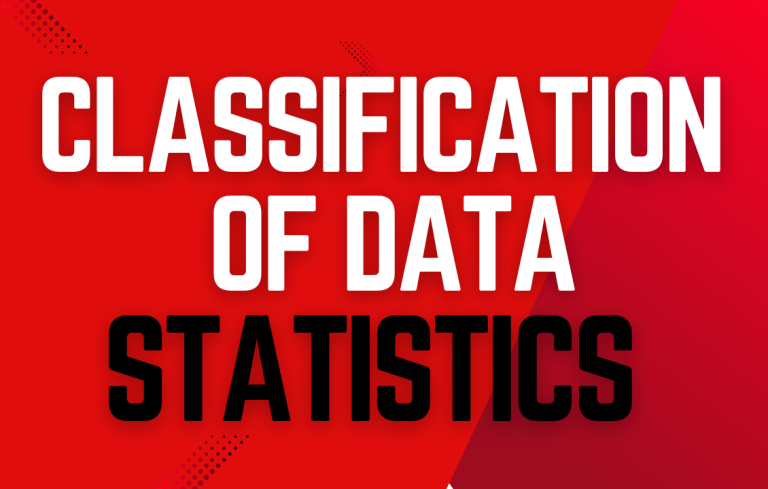Table of Contents
1. What is Data?
Before we talk about classification, we need to understand data.
Data is information or facts collected about anything.
Examples:
- Your classmates’ ages
- Number of books in the library
- Colors of t-shirts
Data is everywhere—we just need to organize it properly to make sense of it.
2. Why Do We Classify Data?
Imagine you have a bag full of mixed candies—red, green, yellow, and blue. Counting or comparing them will be confusing if they are all mixed. So, what do we do? We separate them by color.
This is exactly what classification of data does in statistics.
Definition: Classification of data is the process of arranging data into groups or categories to make it easier to understand and analyze.
3. Types of Data
Data is mainly divided into two types:
A. Qualitative Data (Categorical Data)
- Describes qualities or categories.
- Cannot be measured numerically.
- Answers questions like “What type?” or “Which category?”
Examples:
- Gender: Male, Female
- Colors: Red, Blue, Green
- Fruits: Apple, Banana, Mango
Subtypes:
- Nominal Data: Names or labels without order
- Example: Types of pets – Dog, Cat, Fish
- Ordinal Data: Categories with specific order
- Example: Education level – High School < Bachelor < Master < PhD
B. Quantitative Data (Numerical Data)
- Uses numbers
- Can be measured or counted
- Answers questions like “How many?” or “How much?”
Examples:
- Age of students: 10, 12, 15
- Number of books: 5, 8, 10
- Height in cm: 150, 160, 170
Subtypes:
- Discrete Data: Countable numbers only (whole numbers)
- Example: Number of children in a family – 1, 2, 3
- Continuous Data: Can take any value, including fractions
- Example: Height – 150.5 cm, 160.2 cm
4. Classification Based on Measurement Scale
| Type | Meaning | Example |
|---|---|---|
| Nominal | Names or labels, no order | Color of cars: Red, Blue |
| Ordinal | Categories with order | Rank in a race: 1st, 2nd, 3rd |
| Interval | Numbers with equal intervals, no true zero | Temperature in Celsius |
| Ratio | Numbers with true zero, arithmetic possible | Weight, Height, Age |
5. Example of Classification
| Name | Age | Gender | Marks in Math |
|---|---|---|---|
| Alice | 12 | Female | 85 |
| Bob | 13 | Male | 90 |
| Charlie | 12 | Male | 78 |
| Diana | 14 | Female | 92 |
Classification:
- Qualitative Data: Name, Gender
- Quantitative Data: Age, Marks in Math
- Discrete Data: Age, Marks (whole numbers)
- Continuous Data: Marks (if decimals included)
6. Why Classification is Important
- Organizes data neatly
- Makes it easy to analyze and understand
- Helps in making graphs and charts
- Helps in finding patterns and trends
Think of it like organizing your school bag. If all books, notebooks, and pencils are mixed, it’s a mess. Classification sorts everything so it’s easy to find and use.
7. Quick Tips to Remember
- Qualitative = Quality / Categories
- Quantitative = Quantity / Numbers
- Discrete = Countable
- Continuous = Measurable / Can have fractions
- Nominal = Names, no order
- Ordinal = Ordered categories
8. Practice Questions (Q&A)
Q1. What is data in statistics?
A: Data is information or facts collected about anything.
Q2. Why do we classify data?
A: To group information into categories so it is easy to understand, analyze, and compare.
Q3. Name the two main types of data.
A: Qualitative (categorical) and Quantitative (numerical)
Q4. Give examples of qualitative data.
A: Gender (Male/Female), Colors (Red/Blue/Green), Fruits (Apple/Banana/Mango)
Q5. What is nominal data?
A: Data with names or labels but no order. Example: Types of pets – Dog, Cat, Fish
Q6. What is ordinal data?
A: Data with a specific order. Example: Education Level – High School < Bachelor < Master < PhD
Q7. Give examples of quantitative data.
A: Age of students: 10, 12, 15; Number of books: 5, 8, 10; Height: 150, 160, 170 cm
Q8. Difference between discrete and continuous data?
A: Discrete = countable numbers (1, 2, 3); Continuous = can take any value (150.5 cm)
Q9. What are the four types of measurement scale?
A: Nominal, Ordinal, Interval, Ratio
Q10. Give examples of interval and ratio data.
A: Interval: Temperature in Celsius – 20°C, 25°C
Ratio: Weight – 40 kg, 50 kg
9. Internal/External Links
Internal Links:
- Statistics Basics for Students
- Data Collection Methods
- Graphs and Charts in Statistics
- Types of Data
External Links:
Search Terms:
Classification of Data in Statistics TableTypes of Qualitative and Quantitative DataDiscrete vs Continuous Data InfographicNominal and Ordinal Data Examples
FAQ Schema:
- What is classification of data in statistics?
- What are the main types of data?
- What is nominal data?
- What is ordinal data?
- Difference between discrete and continuous data?
- Why is classification of data important?


